If you’re looking to unlock your subconscious in 2025, I suggest exploring some of the top dream interpretation books like “12,000 Dreams Interpreted,” “Dream Dictionary,” and “The Interpretation of Dreams” by Freud. These guides offer practical symbols, psychological insights, and spiritual perspectives that can deepen your understanding of dreams. They’re perfect for beginners or anyone keen to explore their inner world. Keep going to discover more about tools that can transform your dream work.
Key Takeaways
- These books provide accessible, quick-reference guides ideal for beginners and casual dreamers seeking to understand subconscious symbols.
- Many feature practical tools like journaling prompts, step-by-step analysis, and dictionaries to enhance dream recall and insight.
- They incorporate psychological and spiritual perspectives, including Jungian, Freudian, and biblical approaches, for deeper subconscious exploration.
- Top titles balance simplicity with foundational knowledge, making them useful for ongoing self-awareness and personal growth.
- They’re highly recommended as introductory resources or thoughtful gifts for those interested in unlocking subconscious messages in 2025.
12,000 Dreams Interpreted: A New Edition for the 21st Century
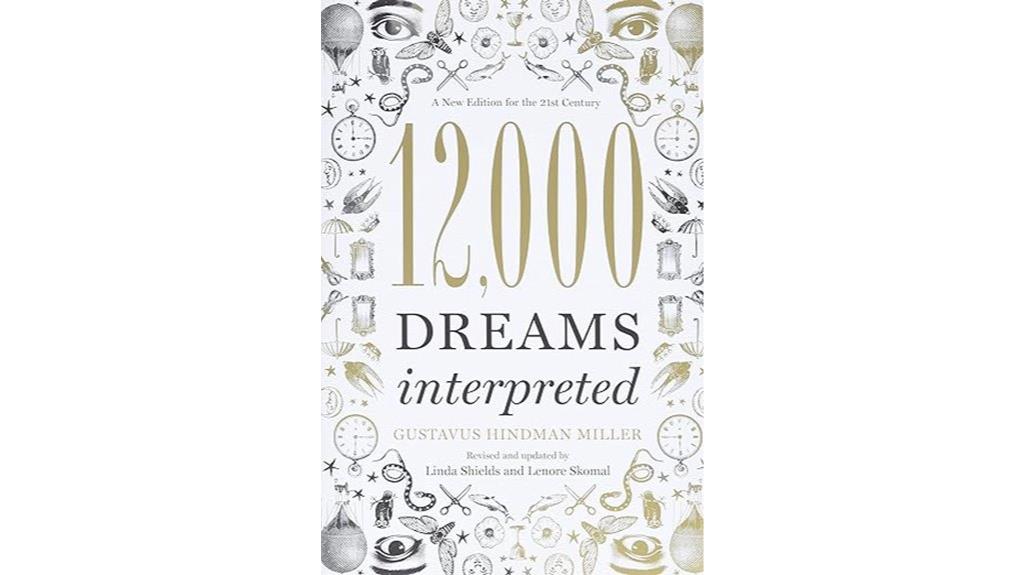
If you’re looking for a practical and accessible guide to understanding your dreams, “12,000 Dreams Interpreted: A New Edition for the 21st Century” is an excellent choice. This updated edition refreshes the original with new entries and modern symbols, like Disco, making it relevant today. It offers a concise 10-page introduction compared to the longer preface of the past, focusing on key insights. Many readers find it helpful for decoding their dreams and gaining subconscious understanding. While some critique its simplicity, its alphabetized entries make it user-friendly, perfect for casual use or gifting. Overall, it’s a popular, affordable resource for exploring dream symbolism.
Best For: casual readers and families seeking an accessible, alphabetized guide to dream symbols and interpretations.
Pros:
- Easy-to-navigate alphabetical entries ideal for quick reference
- Modern symbols and updated content make it relevant for the 21st century
- Affordable price and attractive presentation make it a popular gift
Cons:
- Criticized for simplistic, sometimes humorous interpretations lacking depth
- Missing detailed analysis or nuanced understanding for serious dream study
- Physical condition of copies can vary, with minor damages sometimes present
The Dream Interpretation Dictionary: Symbols, Signs, and Meanings
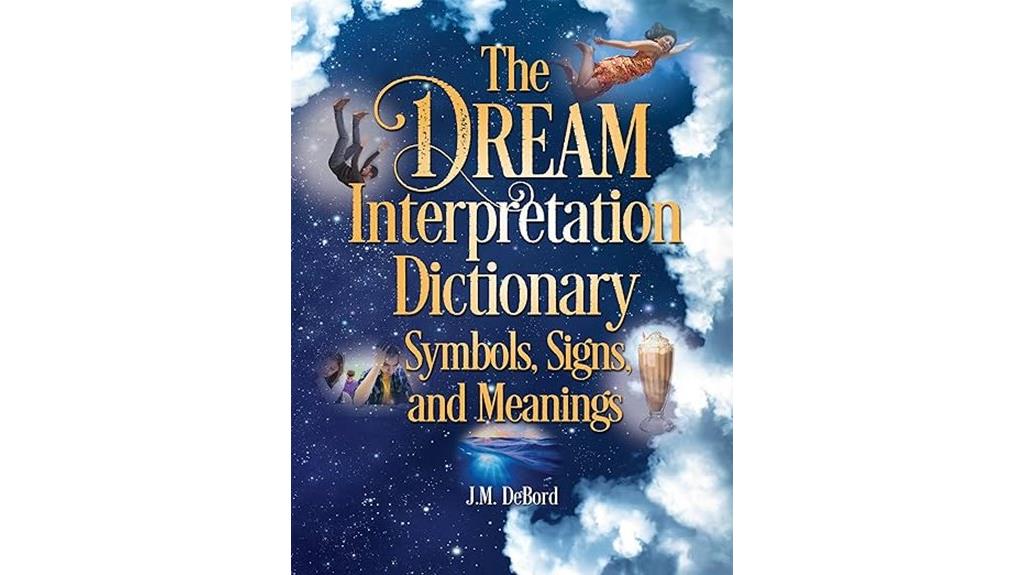
The Dream Interpretation Dictionary: Symbols, Signs, and Meanings is an excellent resource for anyone enthusiastic to decode the messages hidden in their dreams. As someone who’s been fascinated with dreams since childhood, I found this dictionary incredibly helpful. It offers simple, accessible guidance on understanding symbols, colors, shapes, and patterns. Inspired by J.M. DeBord’s work, I learned techniques to remember dreams vividly, which improved my interpretations. Interacting with communities online deepened my insights, especially about recurring themes. This book became my bedside companion, empowering me to recognize health alerts and emotional signals, revealing my subconscious potential with clarity and confidence.
Best For: individuals curious about dream symbolism and seeking straightforward, practical guidance to interpret their dreams for personal growth and self-awareness.
Pros:
- Provides clear, accessible explanations of symbols, colors, shapes, and patterns.
- Helps improve dream recall through easy techniques, enhancing interpretation accuracy.
- Empowers users to recognize subconscious messages related to health, emotions, and personal development.
Cons:
- May contain some repetitive explanations, which can be less engaging for seasoned interpreters.
- Coverage of topics might be broad or limited, potentially missing more specialized symbols.
- Physical copies can have long waiting times, and some users might find the index or cross-references confusing.
Dreamers Dictionary
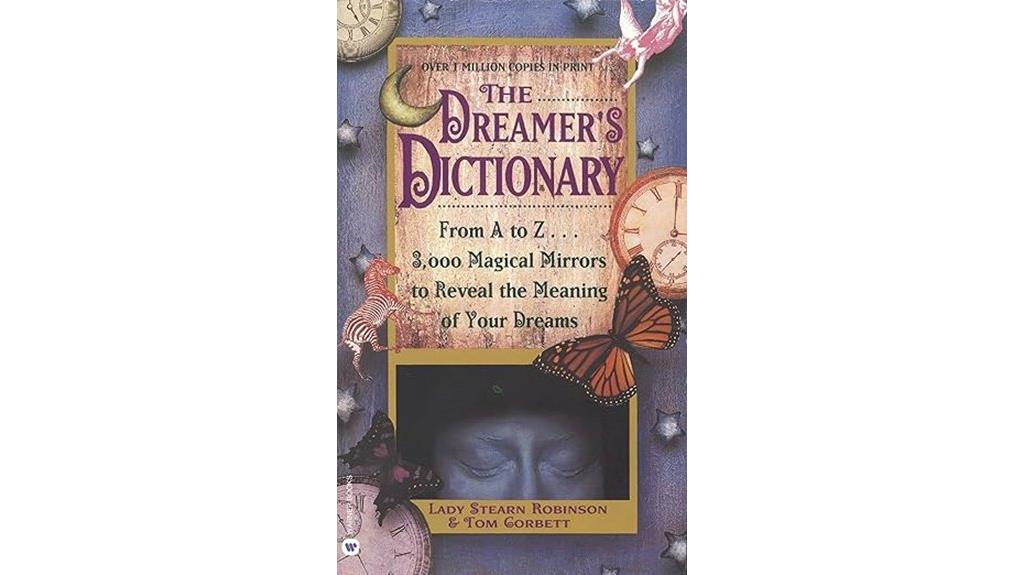
Looking for a straightforward, reliable tool to decode your dreams? The Dreamers Dictionary is exactly that. Many users keep theirs bedside for quick reference, sometimes for decades, especially when trying to understand vivid or nightmares. It’s organized alphabetically, making it easy to look up symbols like teeth or other common themes. The definitions are clear, accurate, and to the point, offering quick insights into your subconscious. Users report that it helps them make sense of confusing dreams, providing reassurance and emotional relief. Overall, it’s a no-nonsense resource that’s highly valued for its simplicity and effectiveness.
Best For: individuals seeking a straightforward, reliable reference to interpret their dreams quickly and accurately, especially those with vivid or recurring nightmares.
Pros:
- Easy to use with alphabetically organized symbols for quick lookup
- Clear, concise, and accurate definitions providing quick insights
- Long-lasting personal resource used for decades, offering reassurance and understanding
Cons:
- Limited to surface-level interpretations without deeper psychological analysis
- Primarily available in English, which may limit accessibility for non-English speakers
- Some editions from different years may have minor variations in content or page count
The Interpretation of Dreams: The Complete and Definitive Text

Anyone interested in gaining deep insights into the subconscious mind will find “The Interpretation of Dreams: The Complete and Definitive Text” an invaluable resource. This classic work by Freud offers a thorough, accessible exploration of dream symbolism and meaning, revealing how dreams replay our life experiences. Though dense and requiring careful reading, it rewards patience with personal clarity and understanding. I’ve found it invaluable for analyzing my own dreams, confirming Freud’s theories through experience. Its beautiful design makes it a treasured addition to any collection. If you’re enthusiastic to decode the mysteries of your dreams, this book provides both foundational knowledge and inspiring insights.
Best For: those interested in deepening their understanding of dreams, subconscious symbolism, and psychological insights through a comprehensive and detailed classic text.
Pros:
- Provides thorough and insightful exploration of dream symbolism and meaning
- Enhances personal understanding and analysis of dreams through Freud’s theories
- Beautifully designed, making it a valuable addition to any collection
Cons:
- Dense and requires careful, slow reading to fully grasp concepts
- Some readers find the content lengthy and occasionally wordy or challenging
- May necessitate multiple readings for complete understanding of the material
Dream Interpretation Guide: Science, Spirituality & Cultural Signs
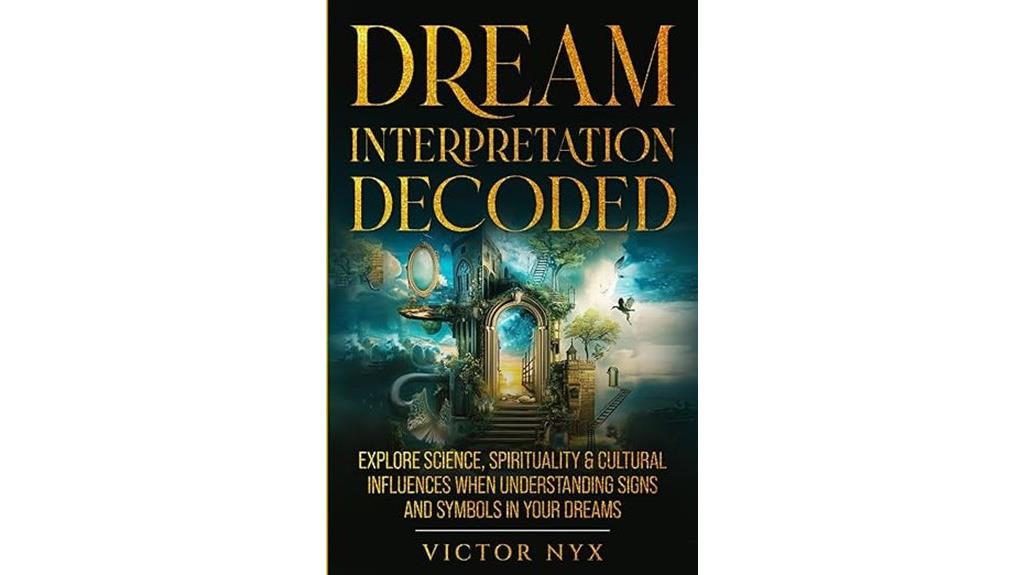
If you’re seeking a thorough approach to understanding dreams that combines scientific insights, spiritual wisdom, and cultural traditions, this guide is ideal for you. It explains sleep stages, brain waves, and neural mechanisms influencing dreams, making neuroscience accessible without jargon. The book also explores how different cultures and religions interpret dreams, from Indigenous visions to Hindu karmic reflections, highlighting their spiritual significance. Instead of rigid symbols, it encourages building personalized dream vocabularies based on your experiences, emotions, and thoughts. Practical techniques like journaling, lucid dreaming, and mindfulness help you actively interpret your subconscious messages and deepen self-awareness, making this guide a versatile tool for personal growth.
Best For: individuals interested in a comprehensive and accessible approach to understanding dreams through science, spirituality, and cultural traditions seeking to build personalized interpretations and practical skills.
Pros:
- Combines scientific, spiritual, and cultural perspectives for a well-rounded understanding of dreams
- Emphasizes personal interpretation and self-awareness over rigid symbol dictionaries
- Offers practical techniques like journaling, lucid dreaming, and mindfulness for active engagement
Cons:
- May require time and effort to integrate multiple approaches into daily practice
- Some readers might prefer more technical neuroscience details or specific cultural teachings
- The broad scope could be overwhelming for those seeking quick, straightforward interpretations
Dream Interpretation Handbook: Guide and Dictionary
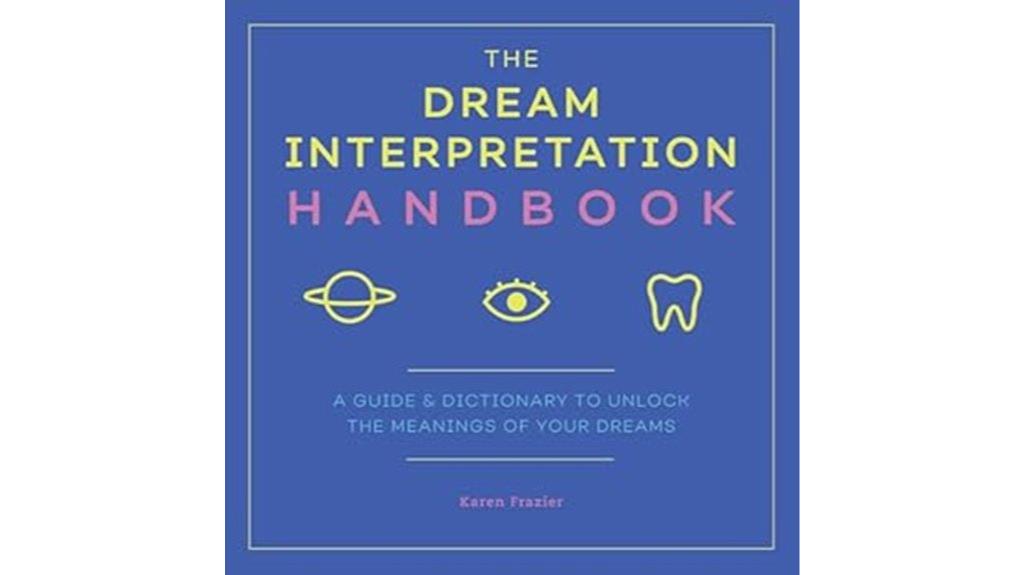
The Dream Interpretation Handbook: Guide and Dictionary is an excellent choice for beginners who want a straightforward and accessible resource to understand their dreams. It offers clear explanations of dream symbols and practical tips for remembering and analyzing dreams without overwhelming psycho-babble. Many readers find it helpful for discovering that dreams carry meaningful messages, encouraging deeper exploration. Its concise format makes it easy to use and understand, whether you’re casual or more serious about dream work. While some wish for more detail, most appreciate its simplicity and usefulness as an introduction or gift. This book makes revealing your subconscious approachable and insightful.
Best For: beginners and casual dreamers seeking a clear, straightforward guide to understanding and analyzing their dreams without complex psycho-babble.
Pros:
- Easy to understand and accessible for all readers
- Offers practical tips for remembering and interpreting dreams
- Concise format makes it quick to reference and use
Cons:
- Some readers wish for more detailed explanations and deeper insights
- May lack advanced or comprehensive dream symbolism for experienced users
- Slightly limited in scope for those seeking an in-depth psychoanalytic approach
A-Z Dream Dictionary: Over 1600 Common Dreams
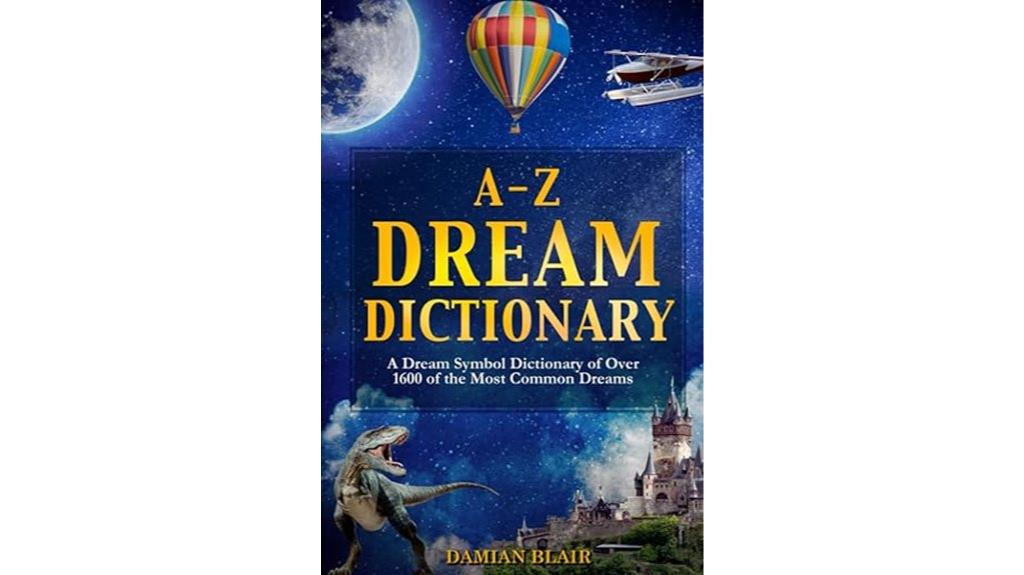
An A-Z Dream Dictionary with over 1600 common dreams is an excellent choice for anyone seeking a practical and accessible guide to understanding their dreams. I find it incredibly helpful for decoding symbols and patterns quickly, thanks to its organized structure and user-friendly layout. Whether you’re new to dream analysis or have experience, this book offers clear explanations and a systematic five-step process to interpret your dreams better. I especially appreciate the emphasis on journaling and recognizing recurring themes, which makes self-discovery engaging and manageable. It’s a versatile resource that connects subconscious imagery to daily life, promoting insight and personal growth.
Best For: individuals seeking an accessible, comprehensive guide to understanding and analyzing their dreams, whether they are beginners or have some experience in dream interpretation.
Pros:
- User-friendly layout with organized categories for quick reference
- Over 1600 common dream symbols with clear explanations
- Emphasizes practical tools like journaling and a systematic five-step analysis process
Cons:
- May lack in-depth psychological or spiritual interpretations for advanced dream analysts
- Some users find certain interpretations too generalized or not personalized enough
- Not specifically tailored for faith-based or highly symbolic dream analysis
Dream Wise: Unlocking the Meaning of Your Dreams
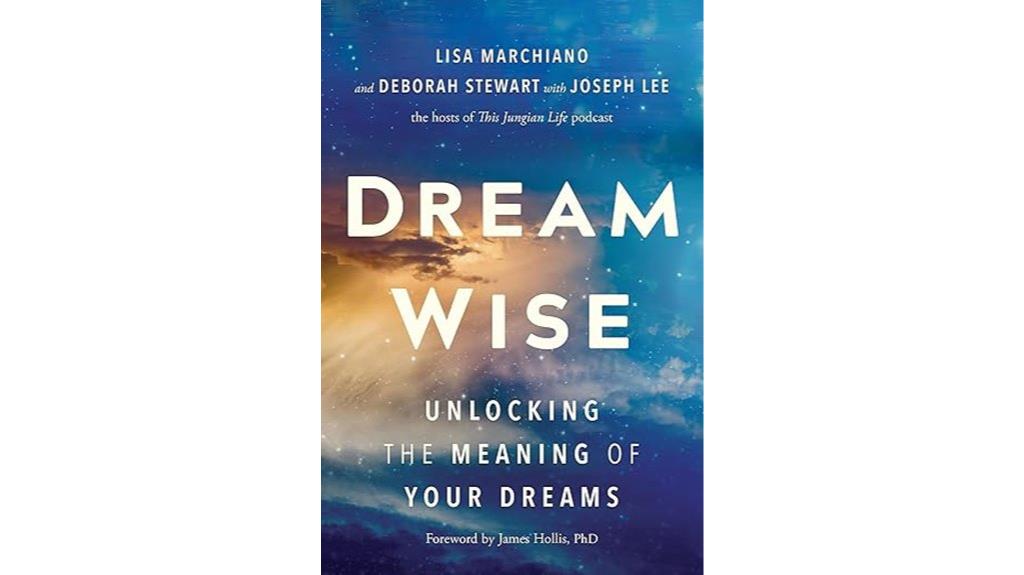
Dream Wise stands out as an ideal choice for both beginners and experienced dreamers seeking a clear, practical guide to understanding their dreams through a Jungian lens. I find its straightforward approach, free of jargon, makes complex concepts accessible. The book offers practical tools like prompts, checklists, and methods to decode symbols, making dream analysis approachable. Its grounding in Jungian psychology helps me explore archetypes, the inner dream maker, and personal symbols with confidence. Many users share how it deepened their self-awareness and offered meaningful insights. If you’re looking for a exhaustive yet easy-to-understand resource, Dream Wise is a trusted guide to revealing your subconscious.
Best For: beginners and experienced dreamers seeking a clear, practical, and accessible guide to understanding dreams through Jungian principles.
Pros:
- Highly accessible and jargon-free, making complex concepts easy to understand
- Practical tools like prompts, checklists, and methods to decode symbols effectively
- Grounded in Jungian psychology, enhancing insights into archetypes and personal symbols
Cons:
- May lack in-depth exploration for advanced or professional dream analysts
- Some readers might prefer more detailed or academic perspectives on Jungian theory
- The focus on practical tools might oversimplify some of the more nuanced aspects of dream interpretation
The Divinity Code to Understanding Your Dreams and Visions
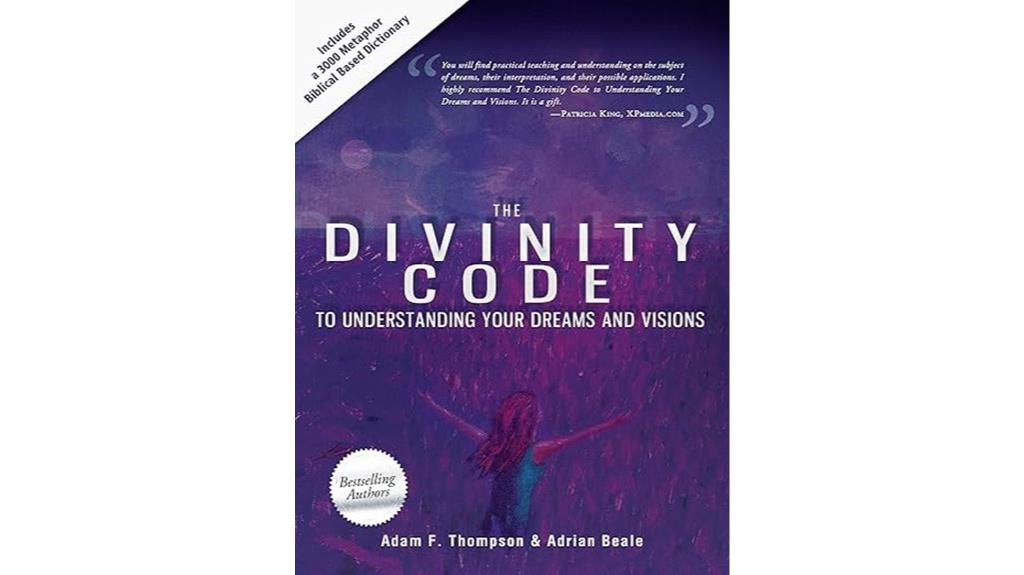
If you’re serious about understanding the divine messages hidden in your dreams, The Divinity Code to Understanding Your Dreams and Visions offers a solid, Bible-based approach that’s perfect for believers seeking to deepen their spiritual insight. This book emphasizes that dreams and visions are divine communication, rooted in biblical accounts. It provides practical tools like detailed dictionaries for symbols, metaphors, and places, making interpretation accessible. Many readers have experienced breakthroughs—gaining clarity, prophetic insight, and spiritual growth. Overall, it’s a highly recommended resource that helps believers recognize God’s messages, strengthen their prophetic gifting, and deepen their relationship with Christ through scriptural understanding.
Best For: believers seeking a biblical, practical guide to understanding and interpreting their dreams and visions to deepen their spiritual connection and prophetic gifting.
Pros:
- Provides a solid, Scripture-based foundation for dream interpretation.
- Includes detailed dictionaries for symbols, metaphors, and places to aid understanding.
- Offers real-life examples and step-by-step guidance suitable for both beginners and experienced dreamers.
Cons:
- May require time and effort to fully grasp and apply all interpretation tools.
- Focuses primarily on biblical and spiritual meanings, potentially overlooking secular perspectives.
- Some readers might find the detailed dictionaries and concepts overwhelming at first.
What Your Dreams Are Telling You: Unlocking Solutions While You Sleep

People who are curious about uncovering hidden messages in their dreams will find “What Your Dreams Are Telling You: Unlocking Solutions While You Sleep” especially helpful. This book guides you through remembering dreams, identifying their sources, and interpreting symbols to reveal solutions and insights. Cindy McGill emphasizes how dreams inspire creativity, innovation, and spiritual growth, supported by biblical and historical examples. It offers practical tools like a dream dictionary and journaling templates, making complex symbolism accessible. Many readers have experienced emotional breakthroughs and gained clarity by applying these techniques, making this book a valuable resource for tapping into your subconscious while you sleep.
Best For: individuals interested in understanding dream symbolism, spiritual growth, and unlocking subconscious insights through practical interpretation tools.
Pros:
- Provides a comprehensive guide to remembering, analyzing, and interpreting dreams
- Includes useful resources like a dream dictionary and journaling templates to facilitate understanding
- Supports spiritual growth with biblical and historical examples inspiring creativity and innovation
Cons:
- Some readers find the blend of spirituality, Christianity, and psychoanalysis unscientific or wishful
- May be confusing or less practical for those seeking purely scientific or clinical approaches to dreams
- Not all readers experience significant breakthroughs, and some may find the techniques less effective
The Interpretation of Dreams
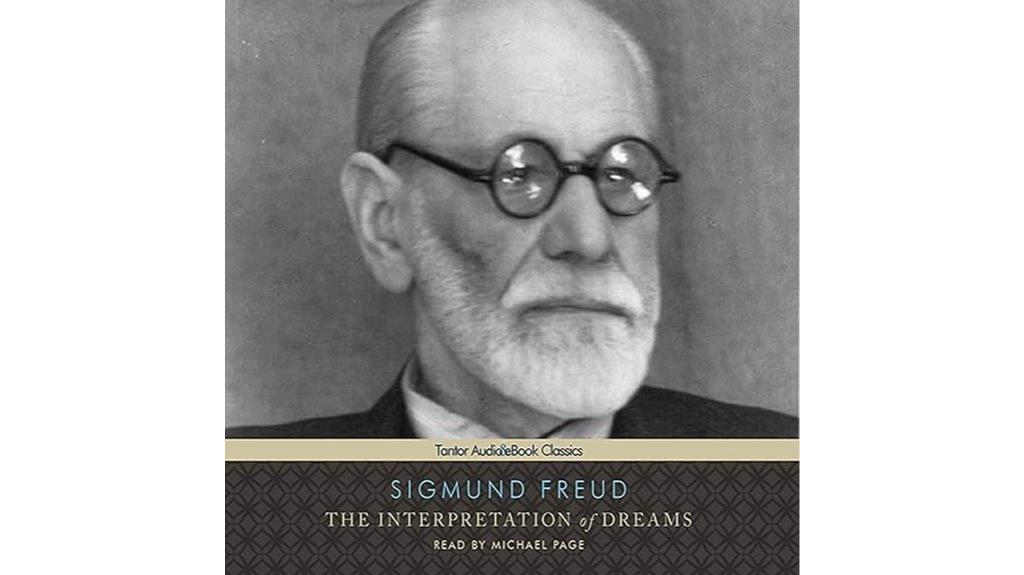
For anyone deeply curious about uncovering the hidden meanings behind their dreams, “The Interpretation of Dreams” by Sigmund Freud offers a compelling starting point. This pioneering work, first published in 1899, explores dreams as the royal road to the unconscious, revealing repressed wishes and inner conflicts. Freud’s approach involves analyzing symbols and narratives to uncover underlying desires, often drawing from personal dreams. While some concepts are dense and rooted in early psychology, the book’s influence on dream analysis and psychoanalysis is undeniable. It opens a window into the layered complexity of the mind, inspiring generations to explore the subconscious beneath their dreams.
Best For: individuals interested in understanding the symbolic and psychological meanings behind their dreams and exploring psychoanalytic concepts.
Pros:
- Provides a foundational and influential approach to dream analysis and the subconscious.
- Offers deep insights into human desires, conflicts, and emotional processes.
- Inspires ongoing interest in psychology, culture, and self-awareness through its pioneering ideas.
Cons:
- The language can be dense and technical, requiring multiple readings for full comprehension.
- Some theories are outdated, with modern neuroscience questioning Freud’s symbolic interpretations.
- The book’s focus on psychological over physiological explanations may limit its scientific accuracy by today’s standards.
The Dream Dictionary from A to Z
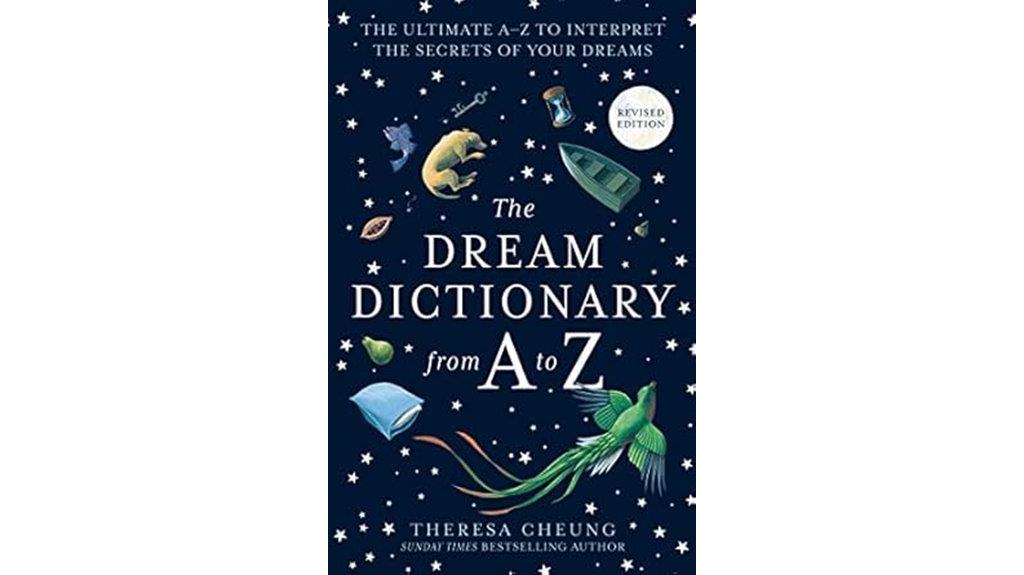
Looking for a dream interpretation guide that combines spiritual insight with practical explanations? I found “The Dream Dictionary from A to Z,” and it’s incredibly helpful. It offers detailed descriptions of symbols, blending spirituality with psychology, which feels authentic and trustworthy. I use it daily for self-reflection, appreciating its straightforward, jargon-free language. While it covers many symbols, some gaps exist, like missing eclipses or certain symbols. Still, its cultural and historical insights deepen understanding. Many readers, including myself, find it an accessible, reliable tool for reveal subconscious thoughts and gaining clarity about our dreams and inner reactions.
Best For: those seeking a trustworthy, comprehensive dream interpretation guide that blends spiritual insight with practical, easy-to-understand explanations.
Pros:
- Offers detailed descriptions of symbols, combining spirituality with psychology for deeper understanding
- Clear, jargon-free language making it accessible for casual and serious dreamers alike
- Rich cultural and historical insights that enhance overall comprehension of dream symbolism
Cons:
- Some symbols, such as eclipses or multiple moons, are missing from the coverage
- Occasional misprints or missing sections, like the P section, can limit usability
- Not entirely exhaustive, so certain symbols or scenarios may not be included
The Dream Dictionary: An A-Z guide to dream symbols and psychology
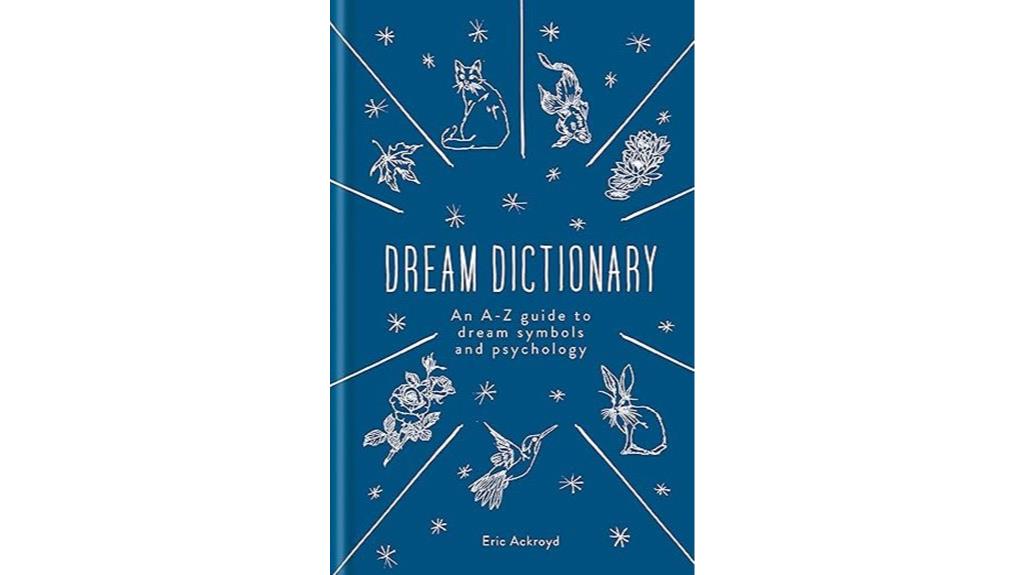
If you’re seeking a complete and user-friendly guide to understanding dream symbols, The Dream Dictionary: An A-Z guide to dream symbols and psychology is an excellent choice. I found its extensive coverage of symbols, from objects to abstract ideas, incredibly helpful for decoding complex dreams. The explanations are clear, balanced, and rooted in theories by Freud and Jung, adding depth to interpretations. Its alphabetized format makes it easy to find meanings quickly, whether you’re a beginner or experienced dreamer. While some interpretations may feel a bit over the top, overall, I think it’s a practical tool for exploring your subconscious and gaining meaningful insights into your dreams.
Best For: those interested in deepening their understanding of dream symbols and psychology, whether beginners or experienced dream enthusiasts.
Pros:
- Extensive coverage of dream symbols from objects to abstract ideas, making it a comprehensive resource.
- Clear, balanced explanations rooted in Freud and Jung’s theories, adding depth to interpretations.
- Alphabetized format allows for quick and easy navigation, suitable for all levels of experience.
Cons:
- Some interpretations may come across as overly sexualized or not relevant to every reader’s experience.
- A few users find certain symbols’ interpretations to be exaggerated or overly simplistic.
- Occasionally, the language or examples may feel a bit corny or outdated to some readers.
Factors to Consider When Choosing a Dream Interpretation Book

When selecting a dream interpretation book, I consider how deeply it explores symbols and meanings, ensuring it matches my needs. I also look for works that align with my cultural or spiritual beliefs and offer practical tools to apply insights. Additionally, I check if the book provides clear explanations and is easy to use, making the process more accessible.
Interpretation Depth Level
Choosing a dream interpretation book depends heavily on how deeply you want to explore your dreams. If you’re seeking detailed analysis, look for books that offer thorough symbolism and explore complex themes, including psychological or spiritual dimensions. Some books incorporate theoretical frameworks like Jungian or Freudian perspectives, which can deepen your understanding. If you prefer practical tools, choose one that provides exercises, journaling prompts, or methods for deeper analysis. Consider the author’s approach—whether scientific, spiritual, or a blend—as it influences the depth and style of interpretation you’ll get. A more in-depth book may challenge you with layered meanings, while a surface-level guide might suit casual dreamers. Think about your goals to select a book that truly matches your desired level of insight.
Cultural and Spiritual Focus
Selecting a dream interpretation book with a cultural and spiritual focus requires paying close attention to how it aligns with your personal beliefs and worldview. I look for books that emphasize cultural symbolism and spiritual traditions, whether indigenous, religious, or prophetic, to see if they resonate with my perspective. If I seek divine insights, I choose resources that incorporate spiritual frameworks like prayer, meditation, or rituals that foster growth. I also consider whether the book explores multicultural dream symbols to understand both universal and culturally specific meanings. Most importantly, I want a book that respects and integrates spiritual practices, guiding me to connect my dreams with divine messages or higher consciousness. This alignment helps deepen my understanding and makes the interpretation more meaningful.
Practical Tools Included
Practical tools play a vital role in making dream interpretation more accessible and effective. When choosing a book, look for features like journaling prompts and dream dictionaries that encourage active engagement with your dreams. Step-by-step analysis methods help you break down symbols systematically, making interpretation clearer. Reputable books often include techniques such as mindfulness exercises or lucid dreaming practices, which deepen your insight. Structured approaches, like categorizing symbols or offering analysis frameworks, make the process more systematic and less overwhelming. Additionally, exercises that promote regular dream recall help you build a personal dream vocabulary, improving accuracy over time. Tools that foster emotional awareness and self-reflection lead to more meaningful, personalized interpretations, making the journey into your subconscious both rewarding and practical.
Theoretical Foundations Offered
Understanding the theoretical foundation of a dream interpretation book is essential because it shapes how symbols and themes are analyzed. Whether the book leans on Freudian, Jungian, spiritual, or scientific frameworks, it influences how I interpret my dreams—whether focusing on subconscious desires, archetypes, spiritual messages, or brain activity. Knowing the underlying approach helps me decide if the book aligns with my beliefs and preferred methods of analysis. Books grounded in established psychological theories often include references to concepts like the unconscious mind or sleep neuroscience, making interpretations more credible. Being aware of the theoretical basis also enables me to critically evaluate the insights offered and apply them meaningfully to my own experiences, ensuring I get the most value from my reading.
Usability and Accessibility
When choosing a dream interpretation book, usability and accessibility are key factors that can make a big difference in how effectively I can learn and apply insights. A user-friendly book should use clear, straightforward language that’s easy to understand, whether I’m a beginner or experienced dreamer. Features like alphabetical organization, quick reference guides, and exhaustive indexes help me find symbols and meanings quickly. Practical tools such as journaling prompts, step-by-step instructions, or visual aids make active dream analysis easier and more engaging. The format should cater to different learning styles, offering concise definitions or detailed explanations and cultural contexts. Above all, avoiding complex jargon keeps interpretation approachable, ensuring I stay motivated and confident in my dream exploration.
Frequently Asked Questions
How Do Cultural Differences Influence Dream Symbolism?
Cultural differences hugely influence dream symbolism because what signifies luck in one culture might mean danger in another. I’ve found that understanding these nuances helps me interpret dreams more accurately. For example, a snake can symbolize healing in some traditions but temptation elsewhere. By exploring cultural contexts, I gain deeper insights into my dreams, making my interpretations more meaningful and personalized. It’s a fascinating way to connect with my subconscious across diverse backgrounds.
Are There Scientific Methods to Validate Dream Interpretations?
Think of dream interpretations as maps guiding us through uncharted territories; they’re insightful but not exact. Scientific methods like brain imaging and EEG can measure brain activity during dreams, but they can’t fully validate symbolic meanings. I believe in combining these tools with personal reflection to navigate your subconscious, understanding that dreams are more like a poetic language—sometimes open to interpretation rather than strict validation.
Can Dream Books Help With Recurring Nightmares?
Absolutely, dream books can help with recurring nightmares. I’ve found that understanding symbols and themes in these books provides insight into my fears, allowing me to confront them more effectively. They act as a guide, helping me decode what my subconscious is trying to tell me. While they’re not a cure-all, they definitely offer valuable perspectives that can reduce the frequency and intensity of nightmares over time.
What Is the Role of Intuition in Interpreting Dreams?
I believe intuition plays a vital role in interpreting dreams because it helps me connect symbols and feelings to my personal experiences. While books provide guidance, I trust my gut to understand what my dreams truly mean. Sometimes, I just feel a certain way about a dream, and that insight often reveals what my subconscious is trying to tell me. Listening to my intuition makes the process more meaningful and accurate.
How Do Personal Experiences Shape Dream Meanings?
Personal experiences color my dreams like a painter’s palette, shaping their symbols and themes. I notice that familiar places or emotions often appear, revealing my inner truths. When I reflect on my past, I find clues to what my subconscious is telling me. Your unique life events act as a lens, giving your dreams personal meaning. Embracing this helps me understand myself better and access hidden insights.
Conclusion
If you’re serious about discovering the secrets of your subconscious, these books are your ultimate keys—capable of revealing truths so profound they could change your life forever. Trust me, once you immerse yourself in these pages, you’ll wonder how you ever navigated your dreams without them. They’re not just books; they’re the secret code to understanding the universe within you. Ready to unlock your mind’s deepest mysteries? Let’s get started!









